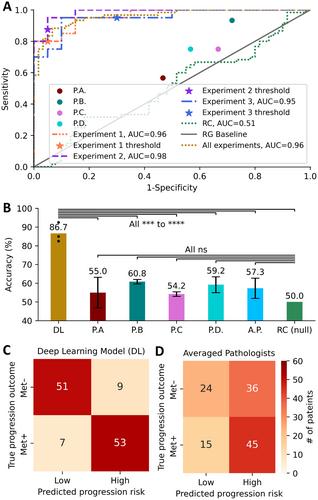AI-guided histopathology predicts brain metastasis in lung cancer patients
Haowen Zhou, Mark Watson, Cory T Bernadt, Steven (Siyu) Lin, Chieh-yu Lin, Jon H Ritter, Alexander Wein, Simon Mahler, Sid Rawal, Ramaswamy Govindan, Changhuei Yang, Richard J Cote
下载PDF
{"title":"AI-guided histopathology predicts brain metastasis in lung cancer patients","authors":"Haowen Zhou, Mark Watson, Cory T Bernadt, Steven (Siyu) Lin, Chieh-yu Lin, Jon H Ritter, Alexander Wein, Simon Mahler, Sid Rawal, Ramaswamy Govindan, Changhuei Yang, Richard J Cote","doi":"10.1002/path.6263","DOIUrl":null,"url":null,"abstract":"<p>Brain metastases can occur in nearly half of patients with early and locally advanced (stage I–III) non-small cell lung cancer (NSCLC). There are no reliable histopathologic or molecular means to identify those who are likely to develop brain metastases. We sought to determine if deep learning (DL) could be applied to routine H&E-stained primary tumor tissue sections from stage I–III NSCLC patients to predict the development of brain metastasis. Diagnostic slides from 158 patients with stage I–III NSCLC followed for at least 5 years for the development of brain metastases (Met<sup>+</sup>, 65 patients) versus no progression (Met<sup>−</sup>, 93 patients) were subjected to whole-slide imaging. Three separate iterations were performed by first selecting 118 cases (45 Met<sup>+</sup>, 73 Met<sup>−</sup>) to train and validate the DL algorithm, while 40 separate cases (20 Met<sup>+</sup>, 20 Met<sup>−</sup>) were used as the test set. The DL algorithm results were compared to a blinded review by four expert pathologists. The DL-based algorithm was able to distinguish the eventual development of brain metastases with an accuracy of 87% (<i>p</i> < 0.0001) compared with an average of 57.3% by the four pathologists and appears to be particularly useful in predicting brain metastases in stage I patients. The DL algorithm appears to focus on a complex set of histologic features. DL-based algorithms using routine H&E-stained slides may identify patients who are likely to develop brain metastases from those who will remain disease free over extended (>5 year) follow-up and may thus be spared systemic therapy. © 2024 The Authors. <i>The Journal of Pathology</i> published by John Wiley & Sons Ltd on behalf of The Pathological Society of Great Britain and Ireland.</p>","PeriodicalId":232,"journal":{"name":"The Journal of Pathology","volume":"263 1","pages":"89-98"},"PeriodicalIF":5.6000,"publicationDate":"2024-03-04","publicationTypes":"Journal Article","fieldsOfStudy":null,"isOpenAccess":false,"openAccessPdf":"https://onlinelibrary.wiley.com/doi/epdf/10.1002/path.6263","citationCount":"0","resultStr":null,"platform":"Semanticscholar","paperid":null,"PeriodicalName":"The Journal of Pathology","FirstCategoryId":"3","ListUrlMain":"https://onlinelibrary.wiley.com/doi/10.1002/path.6263","RegionNum":2,"RegionCategory":"医学","ArticlePicture":[],"TitleCN":null,"AbstractTextCN":null,"PMCID":null,"EPubDate":"","PubModel":"","JCR":"Q1","JCRName":"ONCOLOGY","Score":null,"Total":0}
引用次数: 0
引用
批量引用
Abstract
Brain metastases can occur in nearly half of patients with early and locally advanced (stage I–III) non-small cell lung cancer (NSCLC). There are no reliable histopathologic or molecular means to identify those who are likely to develop brain metastases. We sought to determine if deep learning (DL) could be applied to routine H&E-stained primary tumor tissue sections from stage I–III NSCLC patients to predict the development of brain metastasis. Diagnostic slides from 158 patients with stage I–III NSCLC followed for at least 5 years for the development of brain metastases (Met+ , 65 patients) versus no progression (Met− , 93 patients) were subjected to whole-slide imaging. Three separate iterations were performed by first selecting 118 cases (45 Met+ , 73 Met− ) to train and validate the DL algorithm, while 40 separate cases (20 Met+ , 20 Met− ) were used as the test set. The DL algorithm results were compared to a blinded review by four expert pathologists. The DL-based algorithm was able to distinguish the eventual development of brain metastases with an accuracy of 87% (p < 0.0001) compared with an average of 57.3% by the four pathologists and appears to be particularly useful in predicting brain metastases in stage I patients. The DL algorithm appears to focus on a complex set of histologic features. DL-based algorithms using routine H&E-stained slides may identify patients who are likely to develop brain metastases from those who will remain disease free over extended (>5 year) follow-up and may thus be spared systemic therapy. © 2024 The Authors. The Journal of Pathology published by John Wiley & Sons Ltd on behalf of The Pathological Society of Great Britain and Ireland.
人工智能引导的组织病理学可预测肺癌患者的脑转移。
近一半的早期和局部晚期(I-III 期)非小细胞肺癌(NSCLC)患者会发生脑转移。目前还没有可靠的组织病理学或分子学方法来识别那些可能发生脑转移的患者。我们试图确定深度学习(DL)能否应用于 I-III 期 NSCLC 患者的常规 H&E 染色原发肿瘤组织切片,以预测脑转移的发生。我们对 158 名 I-III 期 NSCLC 患者的诊断切片进行了全切片成像,这些患者至少随访了 5 年,发现脑转移(Met+,65 名患者)与无进展(Met-,93 名患者)。首先选择 118 个病例(45 个 Met+ ,73 个 Met- )进行训练和验证 DL 算法,然后分别选择 40 个病例(20 个 Met+ ,20 个 Met- )作为测试集,进行了三次迭代。将 DL 算法结果与四位病理专家的盲审结果进行比较。基于DL的算法能够区分脑转移瘤的最终发展,准确率高达87%(p 5年),因此可以避免系统性治疗。© 2024 作者。病理学杂志》由约翰威利父子有限公司代表大不列颠及爱尔兰病理学会出版。
本文章由计算机程序翻译,如有差异,请以英文原文为准。



